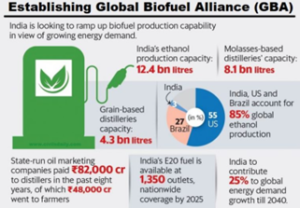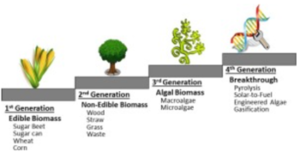Global Biofuel Alliance.
Relevance
- GS Paper 2: Important International institutions, agencies, and fora- their structure, mandate.
- GS Paper 3: Conservation, environmental pollution, and degradation, environmental impact assessment.
- Tags: #upsc #gspaper2 #gspaper3 #biofuelallaince #G20.
Why in the News?
Global Biofuel Alliance is one of the priorities under India’s G20 Presidency.
Understanding Biofuels
- Biofuels are derived from biomass, such as plants or animal waste, and they are considered renewable energy sources due to their replenishable nature, unlike fossil fuels.
- Common sources for biofuels include crops like corn and sugarcane, as well as animal waste like cow dung.
- Biofuels like bioethanol and biodiesel are blended with traditional fuels (petrol or diesel), resulting in cost savings and reduced environmental pollution.
The Significance of GBA Under India’s G20 Presidency
- The establishment of the Global Biofuel Alliance (GBA) is a significant outcome during India’s G20 Presidency.
- This move follows India’s leadership role in multilateral initiatives, exemplified by the International Solar Alliance (ISA) launched during the Paris COP21 in 2015.
- GBA reinforces India’s global position in climate action and its commitment to combat climate change.
What is the Global Biofuel Alliance (GBA)?
- Formation: GBA is being formed by India, Brazil, and the United States, collectively responsible for 85% of global ethanol production.
- Platform: GBA serves as an international platform for sharing best practices, promoting sustainable biofuel development, and enhancing its global application.
- Goal: It aims to influence the global energy landscape and work towards achieving net-zero emissions.
- The Alliance created under the leadership of India includes multiple governmental and private stakeholders, which have come together in order to increase the use of biofuels.
Core Members
- Core members of GBA include India, Brazil, and the United States.
Membership and Endorsement
- Other countries can join GBA by endorsing its foundational document.
- Membership is open to non-G20 nations as well, similar to the International Solar Alliance (ISA).
- Besides the founding members (India, Brazil, and the US), 19 other countries have expressed interest in joining, including Italy, Kenya, and the UAE.
Membership Structure
- GBA will consist of three categories of membership: member countries, partner organizations, and industries.
Objectives of Global Biofuel Alliance (GBA)
- Promoting International Collaboration: Foster international cooperation to encourage the adoption and utilization of biofuels.
- Developing Robust Markets: Work towards creating strong biofuel markets and facilitate global trade in biofuels.
- Enhancing Sustainable Biofuel Usage: Promote the increased use of sustainable biofuels in the transportation sector.
- Policy Development and Support: Develop concrete policy lessons and provide technical support for national biofuels programs worldwide.
- Highlighting Best Practices: Emphasize successful best practices and case studies in the biofuel sector.
- Complementing Existing Initiatives: Collaborate with existing regional and international agencies and initiatives in the fields of bioenergy, bioeconomy, and energy transition, including the Clean Energy Ministerial Biofuture Platform, Mission Innovation Bioenergy initiatives, and the Global Bioenergy Partnership (GBEP).
| When did Biofuel make its debut?
· In 1890, Rudolph Diesel used vegetable oils to power internal combustion engines for agriculture. Which biofuels is common? · Biodiesel, ethanol, and biogas (or compressed biogas). · Ethanol primarily used for blending with petrol. Why use biofuels? · Sustainable source of energy found worldwide. · Helps reduce vehicular emissions. · Raises farmer income and reduces dependence on imported oil, especially in countries like India. · Brazil and Europe are prominent users. Who are the biofuels producer? · The US (57.5 billion litres) and Brazil (35.6 billion litres) were the world’s top ethanol producers in 2022. · Europe led in biodiesel production. · Indonesia was a major biodiesel producer. How much biofuels does India produce? · India produced over 3 billion litres of ethanol. · Aims to produce 15 million tons of compressed biogas per annum by 2023-24. Biofuels utilized in India. · Primarily ethanol for blending with petrol. · Some usage of biodiesel. · Compressed biogas (CBG) employed to enhance city gas networks. · Successful testing of homegrown bio-ATF (Aviation Turbine Fuel), a sustainable aviation fuel, for commercial passenger flights. When did India start its biofuels programme? · The National Biofuels Policy launched in 2009, revised in 2022 to increase ethanol blending to 20% by 2025. · Achieved a 10% blending target five months ahead of schedule in June 2022. · SATAT scheme initiated in 2018 to establish 5,000 CBG (Compressed Biogas) plants for production of 15 million tonne of gas. |
Global Biofuel Alliance Significance for India
- Technology Boost: GBA facilitates technology transfer and climate funding for India’s compressed biogas and third-generation ethanol projects.
- Security: Local production of biofuels reduces the country’s reliance on imported energy. Countries can preserve the integrity of their energy resources and keep them secure from outside influences by limiting their reliance on foreign fuel sources.
- Flex Fuel Vehicles: Introduction of Flex Fuel Vehicles, using Brazilian tech, can reduce emissions and crude oil imports.
- Economic stimulation: Due to the local production of biofuels, biofuel manufacturing facilities can hire hundreds or thousands of people, resulting in the creation of new jobs in rural areas.
- Fuel Blending: India aims to reach E-20 (20% ethanol blending) by 2025-26, learning from Brazil’s E-85 experience.
- Environment Pollution: Although they don’t emit as much carbon as fossil fuels, fertilizers used to cultivate biofuels do produce greenhouse gas emissions.
- Climate Action: GBA puts India at the forefront of climate action, strengthening its climate change fight.
- Biofuel Exports: India can enhance biofuel production and become a major exporter through GBA.
- Energy Independence: GBA supports energy independence by boosting biofuel use.
- Financial Benefits: Increased biofuel production can cut inflation and fiscal deficits, given India’s oil imports.
- Employment: Biofuel investments create job opportunities, especially for youth.
- Farmers’ Aid: Biofuels financially aid sugarcane farmers, and GBA can double this support.
Challenges for Global Biofuel Alliance
- Secrecy Concerns: US reluctance to share tech poses technology transfer challenges.
- Geopolitical Tensions: Opposition from China and Russia may hinder GBA expansion.
- Funding Constraints: Creating sustainable project financing is crucial, but economic downturns and resource scarcity in global institutions pose funding challenges.
- Crop yield and global warming: India’s crop yields have already stagnated, and global warming is expected to reduce yields, which means that the same area under cultivation (arable land) will produce less with time
- Biofuel Import Policies: India’s biofuel import restrictions under its National Biofuels Policy 2018 can limit the global biofuels market’s growth. GBA must address these policies.
- Resource Depletion: Growing biofuel demand may strain water and land resources, affecting crop patterns and discouraging participation from arid, water-scarce African countries.
| Biofuel
· Biofuels derive from organic matter (living or once living) in a short period. · They can be solid (wood, plant material, manure), liquid (bioethanol, biodiesel), or gaseous (biogas). · Substitutes or complements fossil fuels for various uses, including transport, heat, and electricity. · Reasons for adoption include high oil prices, greenhouse gas emissions, and agricultural benefits. Major Types of Biofuels
Categories of Biofuels First Generation Biofuels · Produced from food sources like sugar, starch, and vegetable oil. · Include Bioalcohols, Biodiesel, Vegetable oil, Bioethers, Biogas. · Simpler production but disrupts food economy, leading to higher prices. Second Generation Biofuels · Made from non-food crops or inedible portions of food crops (e.g., stems, husks). · Examples: Cellulose ethanol, biodiesel. · Complex production but doesn’t impact food supply. · Lower greenhouse gas emissions compared to first-gen biofuels.
Third Generation Biofuels · Derived from micro-organisms like algae (e.g., Butanol). · Grown on non-food land, reducing water usage. · Some environmental concerns due to fertilizer use. Fourth Generation Biofuels · Crops engineered to absorb high carbon levels, converted using second-gen techniques · Fuel pre-combusted, carbon captured, and geo-sequestered. · Considered carbon negative, removing carbon from the environment. |
| Sustainable Biomass Use
· The Energy Transitions Commission, in its report on ‘Bioresources within a Net-Zero Emissions Economy’, recommended that biomass should be prioritized for use in sectors where there are limited low-carbon alternatives. · Long-haul aviation and road freight segments, wherein complete electrification might take longer to achieve, could make the cut, whereas petrol vehicles (for which ethanol blending is currently being targeted) would probably not. · According to the International Energy Agency, to achieve net-zero emissions by 2050 globally, sustainable biofuel production needs to triple by 2030 to fuel modes that have few other mitigation options. · Although 1G ethanol is unlikely to fit the bill, 2G ethanol could be counted as a sustainable fuel, especially if the production is decentralized, i.e., crop residues do not have to be transported large distances to a central manufacturing plant. · Balancing economies of scale with the energy needs (and costs) of biomass collection and transport across large distances is a major challenge. · The Global Biofuels Alliance could help drive innovation and technology development in establishing an efficient biomass supply chain and smaller-scale decentralized biofuel production units. · Achieving true sustainability is complex, especially with respect to biofuels. Therefore, any strategy should be carefully examined in the context of the larger ecosystem to avoid unintended negative consequences. |
Sources: Livemint, Business Today
Mains Question
Discuss the significance of the Global Biofuel Alliance for India’s energy and environmental goals. How can this alliance contribute to India’s energy security and sustainability? What are the types of biofuels? (250 words)”






